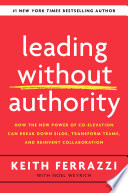

In 'Leading Without Authority', the authors emphasize that influence is more powerful than authority in today's collaborative environments. Traditional leadership models often rely on positional power, but in modern organizations, success hinges on the ability to influence others without formal authority. The book illustrates how influence can be cultivated through relationships, trust, and shared goals. By fostering a culture of collaboration, leaders can inspire and motivate their teams to achieve common objectives, even when they lack direct control. This idea underscores the importance of building rapport and understanding the motivations of others, positioning influence as a crucial skill for effective leadership.
Continue readingThe authors argue that collaboration should be prioritized over competition within teams and organizations. In a rapidly changing business landscape, the ability to work together across functions and disciplines is essential for innovation and problem-solving. 'Leading Without Authority' provides frameworks and strategies for fostering a collaborative environment, encouraging leaders to break down silos and promote cross-functional teamwork. By emphasizing shared success and collective problem-solving, organizations can leverage diverse perspectives and expertise, ultimately leading to more effective solutions and a stronger organizational culture.
Continue readingEmpowering team members and granting them autonomy is a key theme in the book. The authors suggest that when individuals feel trusted and empowered, they are more likely to take initiative and contribute meaningfully to their teams. This empowerment fosters a sense of ownership and accountability, leading to higher levels of engagement and productivity. 'Leading Without Authority' provides practical advice on how to create an environment where team members feel safe to express their ideas, take risks, and collaborate freely. By prioritizing empowerment, leaders can drive innovation and enhance team performance.
Continue readingTrust is a foundational element of effective leadership, especially when leading without authority. The authors highlight that trust must be cultivated intentionally through consistent actions, transparency, and open communication. 'Leading Without Authority' offers insights into how leaders can build trust within their teams and across the organization. By fostering an environment where team members feel valued and respected, leaders can create a culture of psychological safety that encourages open dialogue and constructive feedback. This trust not only enhances collaboration but also enables teams to navigate challenges more effectively.
Continue readingIn today's dynamic business environment, leaders must be adept at navigating complexity and ambiguity. The book discusses the importance of developing a mindset that embraces change and uncertainty. 'Leading Without Authority' provides tools and strategies for leaders to effectively manage complex situations, encouraging them to remain adaptable and resilient. By fostering a culture of continuous learning and experimentation, leaders can empower their teams to tackle challenges creatively and collaboratively. This idea reinforces the notion that effective leadership is not about having all the answers but about guiding teams through uncertainty.
Continue readingEffective communication is essential for leading without authority. The authors emphasize that leaders must be skilled communicators, capable of articulating their vision and inspiring others to rally around it. 'Leading Without Authority' explores various communication strategies, including active listening, storytelling, and feedback mechanisms. By honing their communication skills, leaders can foster a sense of connection and alignment within their teams. This idea highlights the importance of not only conveying information but also creating an environment where team members feel heard and valued.
Continue readingThe concept of a shared vision is central to leading without authority. The authors argue that when teams have a clear and compelling vision, they are more likely to work collaboratively toward achieving common goals. 'Leading Without Authority' provides guidance on how to co-create a vision with team members, ensuring that everyone feels invested in the outcome. By aligning individual motivations with the broader organizational objectives, leaders can foster a sense of purpose and direction that drives engagement and performance. This idea underscores the significance of collective ownership in achieving success.
Continue reading